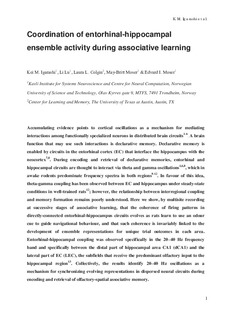| dc.description.abstract | Accumulating evidence points to cortical oscillations as a mechanism for mediating interactions among functionally specialized neurons in distributed brain circuits1, 2, 3, 4, 5, 6. A brain function that may use such interactions is declarative memory—that is, memory that can be consciously recalled, such as episodes and facts. Declarative memory is enabled by circuits in the entorhinal cortex that interface the hippocampus with the neocortex7, 8. During encoding and retrieval of declarative memories, entorhinal and hippocampal circuits are thought to interact via theta and gamma oscillations4, 6, 8, which in awake rodents predominate frequency spectra in both regions9, 10, 11, 12. In favour of this idea, theta–gamma coupling has been observed between entorhinal cortex and hippocampus under steady-state conditions in well-trained rats12; however, the relationship between interregional coupling and memory formation remains poorly understood. Here we show, by multisite recording at successive stages of associative learning, that the coherence of firing patterns in directly connected entorhinal–hippocampus circuits evolves as rats learn to use an odour cue to guide navigational behaviour, and that such coherence is invariably linked to the development of ensemble representations for unique trial outcomes in each area. Entorhinal–hippocampal coupling was observed specifically in the 20–40-hertz frequency band and specifically between the distal part of hippocampal area CA1 and the lateral part of entorhinal cortex, the subfields that receive the predominant olfactory input to the hippocampal region13. Collectively, the results identify 20–40-hertz oscillations as a mechanism for synchronizing evolving representations in dispersed neural circuits during encoding and retrieval of olfactory–spatial associative memory. | nb_NO |
